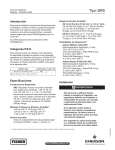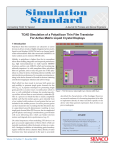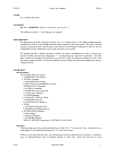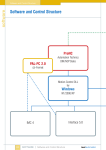Download REGOLATORE ELETTRONICO RCM-2 PER
Transcript
REGOLATORE ELETTRONICO RCM-2 PER GENERATORI A CONDENSATORE ISTRUZIONI PER L’USO RCM-2 ELECTRONIC REGULATOR FOR CAPACITOR GENERATORS OPERATING INSTRUCTIONS RCM-2 instruction manual - January 2010 rev. 05 1 Per un corretto funzionamento di questo regolatore e per evitare di causare guasti all’alternatore è importante seguire le istruzioni riportate in questo manuale. La Mecc Alte S.p.A. non si assume nessuna responsabilità per danni che possono derivare da un utilizzo diverso da quanto qui riportato. It is very important to follow the instructions of this manual both for a correct working of the regulator and to avoid damage to the alternator. Mecc Alte S.p.A. does not assume any responsibility for damages that could come from an use different from that reported here. INDICE -) Campo di applicazione -) Principio di funzionamento -) Brevetto -) Caratteristiche generali -) Operazioni preliminari -) Connessione ai morsetti -) Messa in servizio -) Precisione della tensione -) Potenziometro esterno -) Dimensioni di ingombro CONTENTS -) Field of application -) Principle of operation -) Patent -) General characteristics -) Preliminary operations -) Connection to terminals -) Putting into operation -) Accuracy of the voltage -) Remote potentiometer -) Overall dimensions pag. 2 pag. 2 pag. 3 pag. 3 pag. 4 pag. 4-5 pag. 6-7 pag. 8 pag. 8 pag. 8 page 2 page 2 page 3 page 3 page 4 page 4-5 page 6-7 page 8 page 8 page 8 RCM-2 -) Campo di applicazione Il regolatore RCM-2 è un dispositivo elettronico progettato per mantenere costante la tensione generata esclusivamente dagli alternatori con regolazione a condensatore. Detto regolatore NON PUO’ essere utilizzato in combinazione all’ecologizzatore tipo ECO2 (dispositivo che riduce la velocità del motore quando non è applicato nessun carico all’alternatore). -) Field of application The RCM-2 regulator is an electronic device designed to produce a constant voltage output from alternators with capacitor regulation only. This regulator CAN NOT be used in combination with the energy saver type ECO2 (a device that reduces the speed of the motor when there is no load on the alternator). -) Principio di funzionamento Negli alternatori a condensatore, finchè non intervengono fenomeni di saturazione, la tensione dipende dalla velocità, dalla corrente di carico e dal valore della capacità connessa sull’avvolgimento ausiliario. Si faccia riferimento alla fig. 1; fissata la velocità nominale (ad es. 3600 rpm) e la condizione di vuoto (nessun carico connesso all’alternatore), se viene connesso il condensatore Caux, in uscita si avrà un determinato valore di tensione V1 (per es. 200V); se, in parallelo a Caux viene connesso un altro condensatore che chiameremo Cadd, (risultando quindi connesso all’avvolgimento ausiliario la capacità C = Caux + Cadd) si avrà che la tensione generata V2 aumenterà (per es. 260V). -) Principle of operation In capacitor alternators, in order to avoid saturation phenomena, the voltage is a function of the speed, the load current, and the value of the capacitance connected to the auxiliary winding. Refer to figure 1. Having set the nominal speed (for example 3,600 rpm) and the no-load condition (no load connected to the alternator), if the Capacitor Caux is connected to the output, then a certain value of voltage is reached V1 (for example 200V); if, in parallel to Caux another capacitor that we will call Cadd is connected (resulting in a capacitance of C = Caux + Cadd being connected to the auxiliary winding), the voltage generated will increase to V2 (for example 260V). Syncronization signal Error ERROR AMPLIFIER DIFFER. AMPLIFIER CBIG Threshold Reference Voltage SYNCRO GENER. + - COMP. + - COMP. Forced Switching at Semi-period end Switch-on Request Auxiliary Winding LOGIC POWER SWITCH Switch Enable CSMALL OUT OF RANGE PROTECTION ZERO DETECTOR Out Of Range LED Measured Main Voltage DIFFER. AMPLIFIER SENSING Main Winding fig. 1 RCM-2 instruction manual - January 2010 rev. 05 2 Se mettiamo in serie al condensatore Cadd un interruttore elettronico, modulando il tempo di chiusura di detto interruttore (ton), possiamo regolare la corrente che attraversa il condensatore stesso e quindi è come variassimo il valore del condensatore, conseguentemente varierà anche la tensione di uscita dell’alternatore. Qualora venga applicato un carico, la tensione tenderà a variare secondo la caratteristica di carico della macchina; regolando opportunamente il tempo di chiusura dell’interruttore elettronico (ton) si regola la tensione di macchina. Nel normale funzionamento si ha un riscaldamento degli avvolgimenti dell’alternatore che comporta una variazione della resistenza degli stessi e conseguentemente una variazione della tensione di uscita; questo effetto può essere compensato regolando opportunamente il tempo ton. Al variare della velocità si ha una variazione di tensione dipendente dalla caratteristica tensione/frequenza dell’alternatore: anche in questo caso, (per piccoli scostamenti della velocità dal suo valore nominale) regolando il rapporto ton/T si regola la tensione di macchina. Il regolatore elettronico RCM-2 è dotato di un controllo automatico della tensione impostata che va ad agire sul tempo ton: in questo modo, impostato il valore della tensione di uscita, essa viene mantenuta costante indipendentemente dal carico, dalla temperatura e, entro certi limiti, dalla velocità. If we put an electronic switch in series with the capacitor Cadd, by modulating the closed time (ton) of this switch we can control the current through the capacitor itself which is like varying the value of the capacitor, and so in turn the output voltage of the alternator will vary. If a load is applied, the voltage will tend to vary according to the load characteristic of the machine; suitable regulation of the closed time of the electronic switch (ton) regulates the voltage of the machine. In normal operation the windings of the alternator heat up which causes a change in their resistance and therefore a variation in the output voltage; this effect can be compensated by suitable regulation of the time ton. Changing the speed changes the voltage according to the voltage/frequency characteristic of the alternator: in this case too (by small adjustments in speed from its nominal value) regulating the time ton regulates the machine voltage. The electronic regulator RCM-2 is fitted with automatic control of the applied voltage by adjustment of the time ton: by setting the value of the output voltage in this way, it is held constant regardless of load, temperature, and within certain limits, speed. -) Brevetto -) Patent La richiesta di brevetto del nuovo regolatore è stata depositata il 15 novembre 2000; essa è stata estesa successivamente all’Europa e ai maggiori paesi extraeuropei (n° VI2000A000252). The patent application for the new regulator was lodged on 15 November 2000; it has subsequently been extended throughout Europe and the major countries outside Europe (n° VI2000A000252). -) Caratteristiche generali -) General characteristics Il sistema di regolazione si compone di: The regulation system is made up of: -) regolatore RCM-2 -) RCM-2 regulator -) condensatore ausiliario (Caux): il valore viene determinato come indicato al paragrafo “messa in servizio” -) auxiliary capacitor (Caux): the value is determined as indicated in the paragraph “putting into operation” -) condensatore addizionale (Cadd): il valore viene determinato come indicato al paragrafo “messa in servizio” -) additional capacitor (Cadd): the value is determined as indicated in the paragraph “putting into operation” Le specifiche tecniche sono le seguenti : The technical specifications are as follows: -) tensione di alimentazione 50÷150Vac -) supply voltage 50÷150Vac -) precisione 1% -) accuracy 1% -) stabilita’ termica 2% -) thermal stability 2% -) max corrente sul cond. Cadd 8Amp -) max Cadd capacitor current 8 Amp -) tens. di picco tra i morsetti 5 e 6 650V -) peak volt. between 5 and 6 650V -) range regol. tensione pot. esterno ±5% -) ext. pot. voltage regul. range ±5% -) transitorio attacco carico 200ms ∆V < -10% -) load application transient 200ms -) transitorio stacco carico 400ms ∆V <+10% -) load removal transient 400ms ∆V <+10% N.B. : Tutte le prestazioni si riferiscono a carichi con fattore di potenza unitario. ∆V < -10% N.B.: All specifications refer to loads with a unitary power factor. RCM-2 instruction manual - January 2010 rev. 05 3 -) Operazioni preliminari (solo per generatori con due avvolgimenti ausiliari) ATTENZIONE: Nel caso di alternatori con due avvolgimenti ausiliari non collegati in parallelo, prima di utilizzare il regolatore elettronico RCM-2, i due avvolgimenti stessi con i relativi condensatori devono essere connessi in parallelo, ma prima di fare ciò e necessario verificare che le tensioni ai loro capi siano in fase. Per verificare ed ottenere questo si connettono assieme due terminali, uno di ciascun condensatore e, con l’alternatore in rotazione alla velocità nominale, tramite un tester impostato su Vac, si misuri la tensione tra gli altri due terminali dei condensatori (vedi fig. 2). Il valore misurato deve risultare approssimativamente nullo (fig.2). Se non fosse così, dopo aver arrestato la macchina, invertire il collegamento di uno dei due avvolgimenti ausiliari senza scollegarlo dal proprio condensatore. Una volta determinato con certezza che la tensione descritta sia circa nulla si può procedere a collegare i due avvolgimenti con i rispettivi condensatori, in parallelo. 1 -) Preliminary operations (only for generators having two auxiliary windings) NOTE: In the case of alternators with two auxiliary windings that are not connected in parallel, before using the RCM-2 electronic regulator, the two windings and their relative capacitors must be connected in parallel, but before doing that it is necessary to check that the voltages at their ends are in phase. To make sure of this connect together two terminals, one for each capacitor and, with the alternator running at nominal speed, using a meter set to Vac, measure the voltage between the other two terminals of the capacitors (see fig. 2). The value as measured should be approximately zero (fig. 2). If it is not the case, stop the generator and reverse the connection of one of the two auxiliary windings without disconnecting it from its capacitor. Once it is certain that the voltage as described is approximately zero the two windings with their respective capacitors can be connected in parallel. verde / green Avvolgimenti di eccitazione Excitation windings C1 Condensatore principale Main capacitor Vac 2 verde / green 2 rosso / red C1' Condensatore principale Main capacitor fig. 2 1 rosso / red -) Connessione ai morsetti Con riferimento alle figure 3a e 3b (a seconda che il generatore debba essere collegato a 230V/50Hz-240V/ 60Hz o a 115V/50Hz-120V/60Hz, i terminali del regolatore numerati da 1 a 7 vanno connessi come segue : terminale 1) ad uno dei cavi di uscita dell’avvolgimento principale del generatore. terminale 2) all’altra uscita del principale (regol.230-240) o al morsetto 1 (regol.115/120) terminale 3) potenziometro esterno (100Kohm opzionale) Avvolgimenti di eccitazione Excitation windings Alternatore Alternator -) Connection to the terminals Referring to figures 3a and 3b (according to which the generator must be connected to 230V/50Hz-240V/60Hz or to 115V/50Hz-120V/60Hz), the terminals of the regulator numbered from 1 to 7 are connected as follows: terminal 1) to one of the output leads of the main generator winding. terminal 2) to the other of the output leads (for 230-240 sensing) of the main generator winding or to terminal 1 (for 115-120V sensing). terminal 3) external potentiometer (optional 100 kohm potentiometer). terminal 4) to the central phase of the main generator windings (230/240V sensing) or to the other output main lead (115/120V sensing) terminal 5) to the terminal of the capacitor Caux that is NOT connected to Cadd terminal 6) to the terminal of the capacitor Cadd that is NOT connected to Caux terminale 4) al centro fase degli avvolgimenti principali del generatore (regolaz. a 230/240), o all’altra uscita del principale (regolaz. 115/120) terminale 5) al terminale del condensatore Caux che NON è connesso a Cadd terminale 6) al terminale del condensatore Cadd che NON è connesso a Caux terminale 7) al terminale del condensatore fisso Caux o al terminale del condensatore Cadd che sono connessi assieme terminal 7) to the terminal of the fixed capacitor Caux or to the terminal of the capacitor Cadd which are connected together. RCM-2 instruction manual - January 2010 rev. 05 4 230V-50 Hz - 240V-60Hz fig. 3a fig. 3b Attenzione : Caution : 115V-50 Hz - 120V-60Hz in caso di regolazione a 115/120 V è indispensabile connettere assieme i morsetti 1 e 2. in case of 115/120 V sensing, it is necessary to connect the terminal 1 and 2 together. RCM-2 instruction manual - January 2010 rev. 05 5 Qualunque operazione di connessione o sconnessione dell’RCM-2 o dei condensatori deve essere fatta a macchina ferma. Before any RCM-2 or capacitors wiring operation, ensure that the generator is stationary. -) Messa in servizio -) Putting into operation 1. 1. Se la macchina ha due avvolgimenti ausiliari separati essi devono essere connessi in parallelo secondo quanto indicato al paragrafo “operazioni preliminari”. If the machine has two separate auxiliary windings, they must be connected in parallel as indicated in the “preliminary operations” paragraph. 2. The value of the Caux auxiliary capacitor is to be define experimentaly, WITHOUT CONNECTING the RCM-2 regulator. 2. Il valore del condensatore ausiliario Caux va determinato sperimentalmente SENZA CONNETTERE il regolatore RCM-2 2.1. A seconda del tipo di alternatore, per la prima prova, utilizzare il valore suggerito in tab.A, qualora il tipo non sia presente utilizzare un valore pari a circa il 70% della capacità installata sulla macchina senza regolazione elettronica. 2.1. Depending on the type of alternator, for the first test, use the value given in table A. If the type is not given, use a value of around 70% of the capacity installed on the machine without electronic regulation. 2.2. Avviare la macchina, misurando la tensione sui morsetti dell’avvolgimento principale, verificare l’autoeccitazione della stessa: la tensione erogata deve essere più di 100V, se i due avvolgimenti di statore sono in serie, più di 50V se sono in parallelo. Se questo non avviene, provare a eccitare l’alternatore e se la tensione non raggiunge i valori sopradescritti significa che il condensatore Caux deve essere aumentato al successivo valore commerciale disponibile. 2.2. Start the machine, measuring the voltage on the main connection terminals, check the selfexcitation of this. The voltage delivered must be more than 100V if the two windings are in series and more than 50V if they are in parallel. If this does not occur, try to excite the alternator and if the voltage does not reach the aforementioned values, this means that the Caux capacitor must be increased to the next commercially available value. 2.3.Regolare la velocità di rotazione al massimo valore che si prevede di utilizzare a vuoto. Caricare progressivamente l’alternatore fino a quando la corrente è circa metà del suo valore nominale controllando che la tensione sia sempre inferiore al 90% del valore nominale, se a vuoto o in qualche condizione di carico essa supera tale valore significa che il condensatore Caux è eccessivo e deve essere diminuito al precedente valore commerciale disponibile. 2.3.Adjust the rotation speed to the maximum value intended to be used at no load. Gradually load the alternator until the current is about half its nominal value checking that the voltage is always less than 90% of the nominal value. If the voltage exceeds this value at non-load or under any load conditions, this means that the Caux capacitor is excessive and must be reduced to the next commercially available value down. 3. Arrestare il sistema e connettere il regolatore RCM2 come indicato in fig. 3. 3. Stop the system and connect the RCM-2 regulator as indicated in Fig. 3. 4. Ruotare il trimmer tutto in senso antiorario 4. Rotate the trimmer anticlockwise. 5. Con il regolatore RCM-2 connesso, determinare il valore del condensatore addizionale Cadd 5. With the RCM-2 regulator connected, determine the value of the Cadd auxiliary capacitor. 5.1. A seconda del tipo di alternatore, utilizzare il valore suggerito in tab. A, qualora il tipo non sia presente utilizzare un valore circa uguale a quello del condensatore ausiliario Caux. 5.1.Depending on the type of alternator, use the value given in table A. If the type is not given, use a value which is approximately equal to that for the auxiliary Caux capacitor. 5.2. Portare la macchina alla sua velocità nominale a vuoto. 5.2.Bring the machine to its nominal non-load speed. 5.3. Tarare il trimmer in modo che la tensione sia quella desiderata (una rotazione in senso orario determina un aumento di tensione). 5.3.Calibrate the trimmer to obtain the desired voltage (rotate clockwise o increase the voltage). 5.4. Arrestare il motore di trascinamento quindi riavviarlo fino alla velocità nominale a vuoto. 5.4.Stop the run-in motor then restart it to obtain the nominal non-load speed. 5.5. Verificare che nel giro di qualche secondo la tensione si porti al valore precedentemente impostato, se rimane ad un valore inferiore a quello impostato è probabile che il valore di Caux sia insufficiente: esso dovrebbe essere aumentato al successivo valore commerciale disponibile, in questa eventualità deve essere ripetuta tutta la procedura a partire dal punto 2. 5.5. Run for several seconds and check that the previously set voltage is obtained. If it remains at a lower value than that set, it is likely that the Caux value is insufficient and must be increased to the next commercially available value. In this case, the whole procedure from point 2 must be repeated. RCM-2 instruction manual - January 2010 rev. 05 6 5.6. Caricare progressivamente l’alternatore fino al suo valore nominale controllando che la tensione rimanga costante entro i limiti indicati al paragrafo “precisione della tensione”. Se, all’aumentare del carico si verifica una cospicua diminuzione della tensione, significa che la capacità di Cadd è insufficiente e pertanto deve essere aumentata. 6. 5.6. Gradually load the alternator to its nominal value, checking that the voltage remains constant between the limits indicated in the “voltage specification” paragraph. If, on increasing the load, the voltage reduces significantly, this means that the Cadd capacity is insufficient and must, therefore, be increased. 6. Se dopo un certo tempo (da 15’ a 1h), dipendente dalle dimensioni dell’alternatore, la tensione rimane entro i limiti specificati, si è trovato un valore adeguato di capacità per Cadd. If, after a certain time (from 15’ to one hour), depending on the dimensions of the alternator, the voltage remains within the limits specified, an adequate Cadd capacity value has been found. NOTE: This procedure must be strictly adhered to for installation of the RCM-2 regulator, to guarantee the correct operation of all the parts. NOTA: Per garantire il corretto funzionamento di tutte le parti, nell’installazione del regolatore RCM-2 deve essere scrupolosamente seguita questa procedura. TABELLA A / TABLE A I valori consigliati di Caux e Cadd sono da verificare sperimentalmente. Suggested values of Caux and Cadd are to be verify experimentally. Tipo Type Tens. Voltage V Freq. Freq. Hz Cin Caux Cadd µF µF µF S16W-130 115/230 50 25 16 25 S16W-150 115/230 50 31,5 25 S20W-95 115/230 50 31,5 S20W-110 115/230 50 S20W-130 115/230 S16F-150 S16F-180 Tens. Freq. Voltage Freq. V Hz Cin Caux Cadd µF µF µF S16W-130 120/240 60 25 16 18 31,5 S16W-150 120/240 60 31,5 20 16 25 25 S20W-95 120/240 60 40 25 31,5 35 20 35 S20W-110 120/240 60 40 25 35 50 45 31,5 31,5 S20W-130 120/240 60 40 31,5 31,5 115/230 50 25 18 25 S16F-150 120/240 60 35 25 35 115/230 50 31,5 10+12,5 31,5 S16F-180 120/240 60 31,5 20 25 S20FS-130 115/230 50 20 + 25 25 35 S20FS-130 120/240 60 2 x 25 35 31,5 S20FS-160 115/230 50 31,5+25 40 31,5 S20FS-160 120/240 60 2 x 31,5 40 40 50 2 x 35 35 35+10 60 2 x 40 40 + 14 40 + 20 S20F-200 115/230 Tipo Type S20F-200 120/240 Con Cin si intende il condensatore che è installato sulle macchine di serie senza regolatore elettronico; se il valore di Cin è diverso da quanto indicato in Tab. A, i valori suggeriti per Caux e Cadd potrebbero non essere corretti. Cin means the capacitor installed on mass-produced machines without an electronic regulator; if the Cin value is different from that indicated in Table A, the values suggested for Caux and Cadd may not be correct. NOTA: Qualora la tensione venga regolata a valori diversi da quelli indicati in tab. A, i valori Caux e Cadd potrebbero non essere corretti. NOTE: If the voltage value set-up is different from the one indicated in table A, the values of Caux and Cadd may not be correct. I valori indicati in tabella A sono stati scelti in modo da riutilizzare il più possibile i condensatori installati di serie sulla macchina senza regolatore. E’ possibile che in talune tipologie di alternatori il valore di Caux possa essere aumentato e il valore di Cadd diminuito. Le gamme di valori entro le quali possono essere scelti i valori di Caux e di Cadd sono limitate dai seguenti vincoli: The values indicated in Table A have been chosen to use the capacitors installed on the machines in massproduction without a regulator as often as possible. It is possible that in any type of alternator, the Caux value can be increased and the Cadd value decreased. The ranges of values from which the Caux and Cadd values can be chosen are limited by the following restrictions: Il minimo valore di Caux è quello che permette all’alternatore con regolazione elettronica di autoeccitarsi. The minimum value of Caux is the one which allows the alternator with electronic regulation to self-excite. Il massimo valore di Caux è quello che con qualunque carico connesso all’alternatore e in tutta la gamma di velocità del motore di trascinamento (al variare del carico) permette al regolatore RCM-2 di mantenere la regolazione della tensione al valore impostato. The maximum Caux value is the one which allows the RCM-2 regulator to maintain the regulation of the voltage at the value set with any charge connected to the alternator, throughout the range of run-in motor speeds (with variation of the charge). RCM-2 instruction manual - January 2010 rev. 05 7 NOTA: Un valore eccessivo del condensatore Caux puo’ causare danni al regolatore elettronico. NOTA: An excessive value of the Caux capacitor may cause damages to the electronic regulator. Il minimo valore di Cadd è quello che, con l’alternatore caricato al suo valore nominale a cos ϕ =1, permette di mantenere la tensione entro i limiti di precisione indicati alla minima velocità alla quale si porta il motore di trascinamento in questa situazione di carico. The minimum Cadd value is the one which, with the alternator loaded to its nominal value at cos ϕ =1, allows the voltage to be kept between the limits specified at the minimum speed at which the run-in motor is operating in this load situation. Il massimo valore di Cadd è limitato dalle caratteristiche dello stadio di potenza del regolatore RCM-2: • Con il massimo carico previsto, la massima corrente su Cadd (corrente sul morsetto 6) è 8Arms • Alla massima velocità e con l’alternatore in qualunque situazione di carico, il picco di tensione tra i morsetti 5 e 6 non può superare i 650V. Tutto quanto indicato si riferisce a carichi a cos ϕ = 1. The maximum Cadd value is limited by the characteristics of the power state for the RCM-2 regulator: • With the maximum load provided for, the maximum current on Cadd (current on terminal 6) is 8 Arms • At the maximum speed and with the alternator in any load situation, the voltage peak between terminals 5 and 6 may not exceed 650 V. All the above relates to cos ϕ = 1 loads. -) Precisione della tensione Il regolatore RCM-2 è dotato di un riferimento di tensione altamente stabile e preciso che, unitamente alla strategia di controllo in retroazione, garantisce una precisione dell’1%. -) Accuracy of the voltage The RCM-2 regulator is equipped with a highly stable and accurate reference voltage which, together with the feed-back control system, ensures an accuracy of 1%. -) Potenziometro esterno Un potenziometro esterno da 100KΩ collegato tra i morsetti 3 e 4, permette di variare il valore della tensione impostata di ± 5%. -) Remote potentiometer A remote 100KΩ potentiometer connected between terminals 3 and 4, allows to change the rated voltage value about ± 5%. ATTENZIONE: quando si collega il potenziometro esterno è necessario seguire la procedura sottoriportata per ottenere un corretto funzionamento dell’alternatore. • ruotare il trimmer VOLT nel regolatore completamente in senso antiorario • posizionare il potenziometro esterno a metà corsa e connetterlo agli appositi morsetti del regolatore • tramite il trimmer VOLT del regolatore tarare la tensione al valore nominale CAUTION: in order to get a correct working of the alternator, it is necessary to follow the following procedure, connecting the external potentiometer. • turn the VOLT trimmer of the regulator completely anticlockwise. • set the external potentiometer at half turn and connect it to the proper terminals of the regulator. • adjust the voltage at the nominal value by the VOLT trimmer of the regulator. -) Protezione “Out Of Range” La protezione interviene in quelle condizioni di velocità e carico in cui l'RCM-2 non è è più in grado di regolare la tensione ed essa tende ad aumentare. L'RCM-2 può funzionare in condizioni di “Out Of Range” per circa 20 sec. (esso ha gia perso il controllo della tensione) dopodichè viene permanentemente disabilitato lo stadio di potenza (che regola la corrente nel condensatore Cadd) e si accende il LED rosso "“Out Of Range”. Generalmente il problema è dovuto ad un eccessivo valore del condensatore Caux. Per il ripristino è necessario fermare l'alternatore e riavviarlo. -) “Out Of Range” Protection This protection operates in those conditions of speed and load in which the RCM-2 in not anymore able to adjust the voltage whose value is going to increase. RCM2 can work in “Out Of Range” mode for about 20 sec. (RCM-2 have already lost the voltage control), then the AC power switch (controlling Cadd capacitor current) is permanently disabled and the red LED “Out Of Range” is switched on. Generally the problem is an excessive value of Caux. The reset needs the Gen-Set switching off. -) Dimensioni di ingombro -) Overall dimensions dimensions in mm fig. 4 RCM-2 instruction manual - January 2010 rev. 05 8















![Final Report - [Almost] Daily Photos](http://vs1.manualzilla.com/store/data/005658230_1-ad9be13b69bd4f2e15f58148160b0f22-150x150.png)




